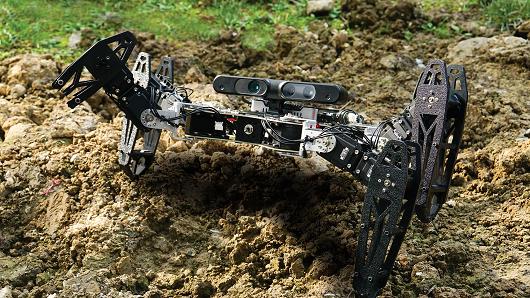A robot that can't be stopped
Interview with
Robots are beginning to play a major part in our lives. They can venture into  places too dangerous or too toxic for a human to do things like search and recovery, chemical cleanups or fire-fighting. But, at the moment, robots are inherently limited by a poor ability to cope when something goes wrong. Now that could be about to change, thanks to a breakthrough by US and French researchers who have developed a revolutionary programming algorithm to make robots "learn like we do". Jeff Clune is one of the team and he spoke to Chris Smith...
places too dangerous or too toxic for a human to do things like search and recovery, chemical cleanups or fire-fighting. But, at the moment, robots are inherently limited by a poor ability to cope when something goes wrong. Now that could be about to change, thanks to a breakthrough by US and French researchers who have developed a revolutionary programming algorithm to make robots "learn like we do". Jeff Clune is one of the team and he spoke to Chris Smith...
Jeff - So, robots will eventually provide tremendous benefit to society especially if we can have them do work that's too dangerous for humans to do, such as putting out forest fires or finding survivors after an earthquake. But they won't be very useful until they can continue to work if they become damaged. So, what we wanted to do in this work is have robots be able to soldier on and continue to do what we've asked them to do even if they become damaged. So, that requires some creative artificial intelligence techniques that we invented.
Chris - Why can't a robot be made to do that currently?
Jeff - Either you could programme a robot ahead of time to execute a very specific sequence of actions, but then when it becomes damaged then that programme no longer works, or you could try to have the robot learn no its own how to adapt to damage but previous techniques have searched through the entire space of possible behaviours, and in our case, that's more molecules than there are on planet Earth. So, what we need was an intelligent way to quickly adapt what you do, or maybe your dog does, when you become damaged as opposed to something that takes hours or days or years sifting through possibilities.
Our approach is very different. We provide the robots with a simulated childhood if you would, where they get to play around in a computer kind of virtual world and learn all the different ways of their bodies work and how to behave. And when they become damaged, they then use those intuitions that they gained during their childhood to figure out a behaviour that works very well despite the damage. So for example, when you were a kid, you probably learned how they walk around on your tiptoes or maybe only walking using your heels or crawling on floors. If suddenly you found yourself with a wound in your heel out in the forest, you'd say, "Right. I'll just pop up onto my tiptoes. I know how to walk that way because I've practiced it before and that allows me to continue on with my hike or get out of the forest and back to a hospital."
Chris - So, how does the algorithm know which of these solutions to apply under which circumstance and how does it find that solution quickly? Because it will have just a huge database of information relevant to, "I can walk on my tiptoes. I can do handstands"? How does it know which one to apply when?
Jeff - Right. So it actually acts very much like a scientist. It has some predictions from its experience about which behaviours will work well, but it doesn't yet know which of those behaviours will work now that it has this new damaged body. And so, it conducts one experiment and tries something out, it gets the data back from the experiment and then it updates kind of its predictions about what it thinks is going to work. So, if the thing it just tried doesn't work at all, and the thing it just tried relies predominantly on the front three legs, it will say, "Okay, I'm going to rule out that entire family of walking behaviours. Let me try something completely different, maybe something that only uses the back three legs." It tries that out, maybe that doesn't work, so it tries something that only uses the front right and the back left. And it says, "Oh! That works just fine and it's off to the races."
Chris - When you say that you are provisioning these robots with a simulated childhood, how did you do that?
Jeff - So, we make a copy of the robot in a virtual world. Basically, you can imagine kind of a video game avatar of yourself or this robot. And then we encourage the robot in this virtual world to play around and try to find the best way to behave. So, we might say, "Try to find the fastest way of walking only on these three legs or only on those three legs or without using your front right leg." One funny story is that we challenged it to try to walk without ever touching any of your feet to the ground which of course, we thought it couldn't do. But it's very creative and surprised us and actually, flipped over under its back and crawled in its elbows quite rapidly without touching any of its feet to the ground.
Chris - Good grief! I mean, that really is intelligence, isn't it?
Jeff - It certainly is a form of artificial intelligence. We find it very creative, very surprising, and oftentimes can come up with solutions you never would've dreamed of.










Comments
Add a comment